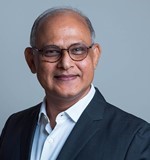Topic: Capturing solar and wind sector opportunities in Southeast Asia
Date :22 April 2021, Thursday
Time :4.00-5.00pm (Singapore Time, GMT+8)
Speakers:

Moderator

Dr. Minh Khoi Le
Lead - Renewable Energy


Dr. Akarin Suwannarat
CTO and EVP


Sunil Gupta
Regional Head - SEA and South Asia


Olivier Duguet
Founder & Chief Executive Officer


Sam Scupham
Associate Vice President, Global Renewable and Distributed Energy - Power Asia
Southeast Asia is one of the fastest-growing regions in the world, in terms of energy demand. The prices of wind and solar have dropped significantly; and reached grid parity, or even lower than thermal electricity.
According to DBS's report "Green Finance Opportunities in ASEAN", the investment opportunity reaches USD$140 billion and USD$35 billion for solar and wind, respectively.
Despite the immense challenges posed by COVID-19, ASEAN energy ministers has agreed to add around 35GW - 40GW of new renewable energy by 2025, according to the ASEAN Plan of Action for Energy Cooperation (November 2020).
In this webinar, speakers will discuss in-depth Southeast Asian markets' potential, as well as what could stand in your way when penetrating these countries and how to overcome these barriers.
Key discussion areas:
1. What is the outlook for solar and wind for ASEAN towards 2025?
2. How is solar and wind Feed-in-Tariff (FiT) scheme evolving among Southeast Asian countries; cost benefit analysis vis-a-sus auction programme?
3. In 2021, is solar/wind + storage bankable in Southeast Asia?
4. What lies in the future of floating solar for Southeast Asia, especially in conjunction with hydropower?
5. How are Southeast Asian countries supporting commercial, industrial, and residential electricity consumers to install their own rooftop solar system?
6. Micro-grid using solar, wind or hybrid energy source (solar/wind + diesel) could help Southeast Asian countries meet 100% electrification, reach the most remote islands and communities previously off grid. What is the opportunity in this field?





